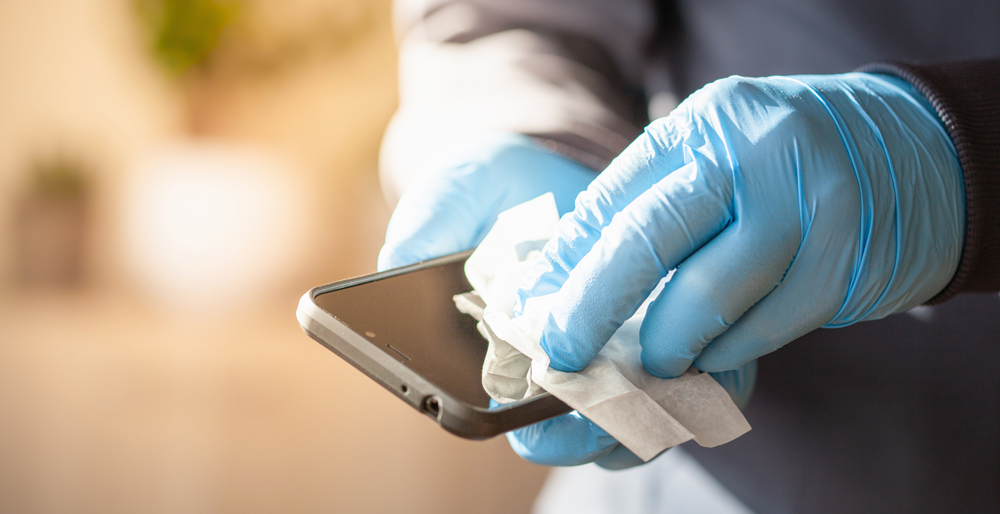Good device hygiene is more important than ever right now. Yet it may be less than obvious which cleaners, cloths and procedures are effective without doing damage to our phones, computers and other devices. Here is a catalog of best practices to help you safely clean these crucial pieces of technology we use every day and seek to protect.

Cleaning Phones
Not everyone has the option of sheltering in place, but even if you’re fortunate enough to stay home right now, there are errands like grocery shopping that continue unabated. We make efforts to wear masks in public, and limit interaction with others to perhaps a few trips to the grocery store per month, yet our phones still travel with us everywhere. If you’re not locked down at home, this includes your place of business and maybe even public restrooms.
The reality is that many of us are constantly setting our phones down on foreign surfaces. Worse, we never seem to stop touching our phones—and we’re all aware of how important clean hands are these days. This makes it imperative that you disinfect your phone regularly.
There are sophisticated (if pricey) solutions to disinfecting phones, as well as earbuds, car keys and other small portable items. UV sanitizers housing multiple tiny UV lamps encase your phone in a tanning-bed-like pod and can destroy the germs that live on its surface in as little as three minutes.
However, if you don’t have north of a hundred dollars to spend, you can get the job done safely with a single-use disinfecting wipe and a soft cloth. Here are the basic Dos and Don’ts:
Dos:
- Consider adding a screen protector to your phone to allow you to clean that surface while reducing the risk of damaging the oleophobic coating on your actual phone screen.
- The Centers for Disease Control and Prevention recommend wearing disposable gloves to clean your devices, and then washing your hands afterward.
- Don’t reuse gloves, since they can harbor virus particles just as your devices can.
- Use only bleach-free disinfecting wipes (e.g., Clorox or Lysol Wipes).
- If the wipe is softer on one side and more abrasive on the other, use the soft side.
- Partially ring out the wipe and swab the phone gently, front and back.
- When you are finished, dry the phone with a soft, microfiber cloth.
- Wipe down your phone case. Separate phone and case before cleaning, and then let each dry thoroughly before reassembling.
Don’ts:
- Phones may be sensitive to excess moisture, so do not saturate your phone.
- Avoid spray cleaners.
- Never submerge your phone in a cleaning solution.
- Do not use bleach.
Other steps for better phone hygiene:
- Be mindful of where you set your phone down.
- Keep wipes in your car for a quick swab after you’ve been running errands.
- To minimize phone contact with your face, use earplugs or a Bluetooth headset to talk.
- Avoid passing your phone around—better to share those photos by text message!
Cleaning Computers
Like phones and tablets, laptops travel with us, making them potential carriers of bacteria and harmful organisms acquired outside the home. In the hierarchy of devices that need regular cleaning, laptops are right behind phones and tablets.
However, if you have a shared desktop computer in your household, it is important that it be disinfected regularly as well. The more people who touch a computer on a daily basis, the greater the odds are that it will come into contact with disease-causing organisms.
Dos:
- Unplug the mouse and keyboard from their USB connections prior to cleaning. You do not need to completely power down.
- As with phones and tablets, wear single-use gloves to clean; discard them and wash your hands afterward.
- As with phones and tablets, use only soft, bleach-free disinfecting wipes.
- Be mindful of how damp the wipe is, and ring out excess liquid before applying.
- Generally, you can clean laptop and desktop screens less frequently than tablets, phones, and touch-screen computers.
- After you wipe down the keyboard, mouse and screen(s) with a disinfecting wipe, use a damp microfiber cloth to swab the surfaces.
- Dry with a second microfiber cloth.
Don’ts:
- Never spray directly onto a computer to clean it.
- Avoid bleach-containing wipes.
- Don’t use paper towels, as they can leave traces of themselves among your computer’s various components.
- Also avoid any towels made of rough material, as well as harsh sponges. Some disinfecting wipes have a more abrasive surface on one side of the wipe; only use the soft side of the wipe.
Getting in the habit of routinely swabbing down phones, tablets, laptops and shared desktop computers will help keep you safe from surface contamination, and hopefully contribute to your peace of mind. Under the present circumstances, phones should be cleaned daily if they have touched foreign surfaces during your errands or workday; schedule regular tablet and laptop cleanings based on exposure; and encourage family members or roommates to swab shared household devices including desktops, after each use.
This article is part of a series on safeguarding and getting the most out of technology during the coronavirus.
To achieve faster internet for smoother browsing, streaming and gaming, click here.
To avoid scams and protect your tech in the at-home era, click here.
To read tips on getting the most out of working from home, click here.








